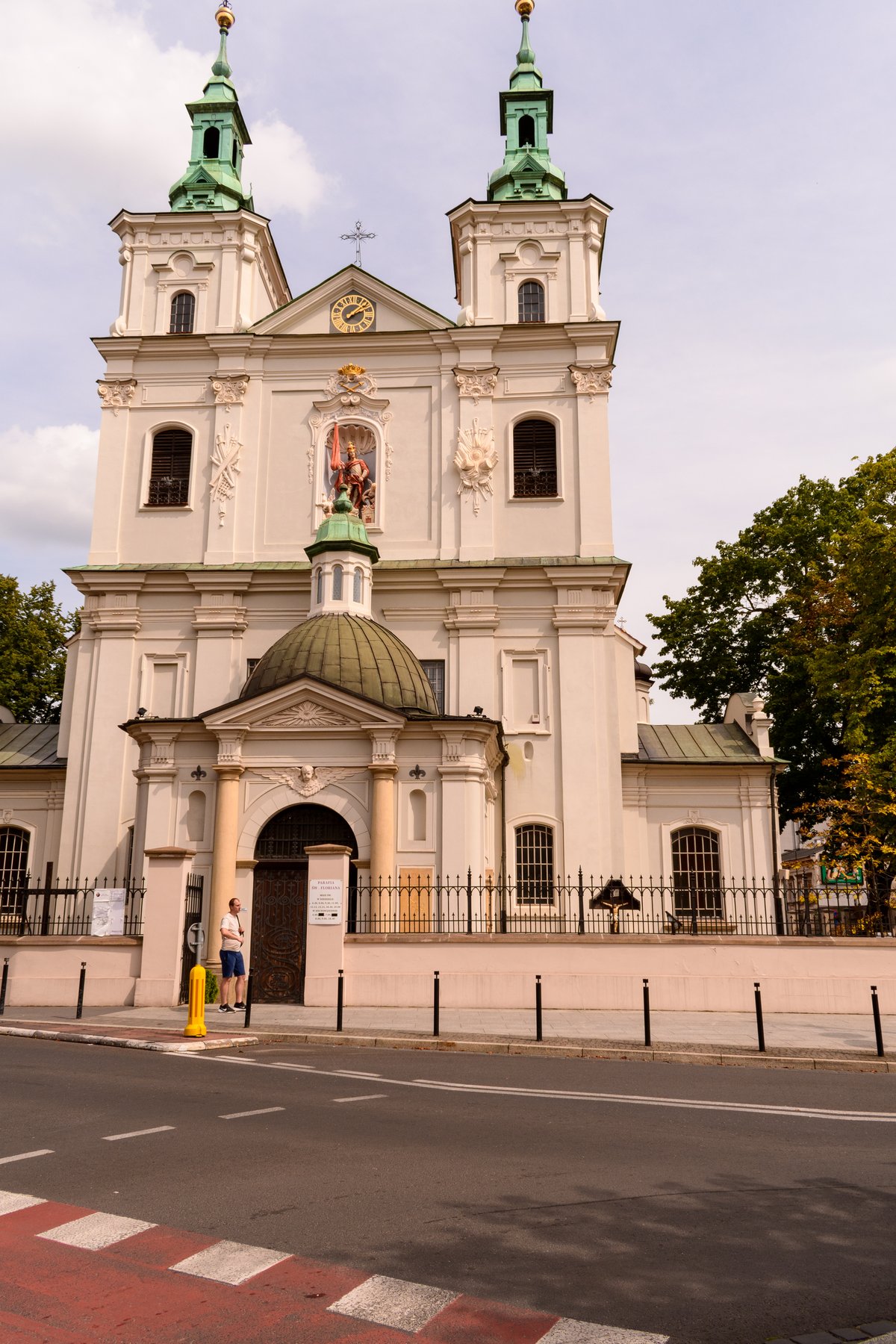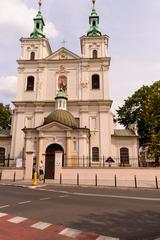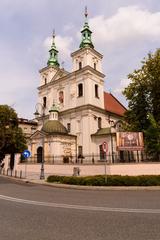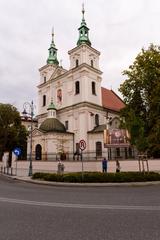
St. Florian’s Church Kraków: Visiting Hours, Tickets & Complete Travel Guide
Date: 14/06/2025
Introduction: St. Florian’s Church and Its Historical Significance
St. Florian’s Church in Kraków, Poland, is a remarkable symbol of the city’s religious, cultural, and architectural heritage. Established in the late 12th century to enshrine the relics of St. Florian—a Roman soldier and Christian martyr—the church has withstood fires, invasions, and political upheavals. Its evolution from Romanesque foundations through Gothic expansions to its present Baroque grandeur mirrors Kraków’s resilience and the changing artistic trends of Central Europe. St. Florian’s Church is not only a sanctuary for worshippers but also a place of national remembrance, having hosted royal ceremonies and served as a spiritual base for Karol Wojtyła, who would become Pope John Paul II. Today, the church continues to draw visitors with its ornate interiors, sacred relics, and enduring role in Polish identity.
This guide provides all the essential information for travelers, history enthusiasts, and pilgrims, including visiting hours, ticketing, accessibility, nearby attractions, and practical tips to enrich your visit.
For additional details, see SpottingHistory, the official parish website swflorian.net, and Kraków’s tourism portal (krakow.pl).
Table of Contents
- Introduction
- Historical Overview
- Visiting St. Florian’s Church: Practical Information
- Artistic and Architectural Features
- Visitor Etiquette & FAQs
- Conclusion & Recommendations
- Sources & Useful Links
Historical Overview
Origins and Early History
St. Florian’s Church (Bazylika św. Floriana), one of Kraków’s oldest religious sites, began construction in 1185 and was completed by 1216 to house the relics of St. Florian, brought to Kraków in 1184 (SpottingHistory). Its foundation marked the church as a spiritual and cultural cornerstone of the city.
Architectural Evolution
Romanesque and Gothic Foundations
The original Romanesque structure featured thick stone walls and semi-circular arches. After suffering from Tatar raids and devastating fires, the church was rebuilt with Gothic elements such as a soaring bell tower, pointed arches, and ribbed vaulting. The church’s silhouette became a city landmark, as depicted in the 17th-century “Civitates orbis terrarum” (swflorian.net).
Baroque Transformation
Following destruction during the Swedish invasions and the 1655 fire, St. Florian’s was rebuilt in the Baroque style (1657–1684), which defines its present character. The ornate façade, twin towers with onion domes, and lavish stucco interiors exemplify Central European Baroque exuberance (krakow.wiki; krakow.travel).
Cultural and Religious Significance
St. Florian is venerated as the patron saint of firefighters and protectors against fire—a devotion reinforced by the church’s survival through several city fires. The church became the University Collegiate Church in the 16th century, playing an important role in Kraków’s academic and royal life. It temporarily housed the remains of Queen Ludwika Maria Gonzaga and national hero Tadeusz Kościuszko. The relics of St. Florian continue to draw pilgrims seeking spiritual intercession (SpottingHistory).
Modern Legacy and Papal Connections
Karol Wojtyła (Pope John Paul II) served as vicar here from 1949 to 1951, shaping his pastoral mission. In 1999, he elevated the church to a minor basilica, reinforcing its spiritual and national importance (swflorian.net).
Visiting St. Florian’s Church: Practical Information
Visiting Hours & Admission
- Monday to Saturday: 6:00 AM – 7:15 PM
- Sunday: 6:00 AM – 9:00 PM
The church is open year-round, though some areas may be inaccessible during services or special events. Entry is free; donations are appreciated. Guided tours or group visits can be arranged for a fee—contact the basilica office for details (swflorian.net).
Accessibility
- The main entrance is street-level, but some interior areas feature steps or uneven floors.
- Ramps are available; visitors with special needs should contact the church in advance for assistance.
- No public restrooms inside; nearby cafes provide facilities.
Guided Tours & Audio Guides
- Group tours and educational visits can be arranged through the parish office.
- Audio guides may be available in multiple languages; check with the church or local tour providers.
How to Get There
- Address: ul. Warszawska 1b, 31-155 Kraków, Poland
- Located at the northern end of the Royal Route, near the Barbican and St. Florian’s Gate.
- Easily accessible by tram, bus (Plac Matejki stop), or a 10-minute walk from the Main Market Square.
- Limited parking; public transport or walking is recommended (swflorian.net).
Nearby Attractions
- St. Florian’s Gate: Kraków’s medieval city gate, a short walk away.
- Barbican: Defensive bastion and architectural landmark.
- Planty Park: Green belt surrounding the Old Town.
- Main Market Square: St. Mary’s Basilica, Cloth Hall.
- Wawel Castle: A key site on the Royal Route.
A recommended itinerary: Begin at St. Florian’s Church, then stroll through St. Florian’s Gate, the Barbican, Planty Park, and end at the Main Market Square.
Special Events
- St. Florian’s Day (May 4th): Major processions, firefighter blessings, and festive Masses.
- Corpus Christi: Citywide processions.
- Christmas & Easter: Elaborate liturgies and music performances.
Artistic and Architectural Features
- Façade: Baroque with twin towers, elaborate stucco, and statuary of St. Florian (krakowtop.org).
- Nave & Chapels: Barrel-vaulted nave with polychrome frescoes and chapels dedicated to various saints, including St. John Paul II.
- Main Altar: Houses the relics of St. Florian, adorned with Solomonic columns, gilded angels, and dramatic Baroque art (thecatholictravelguide.com).
- Organ: Historic Baroque pipe organ, used for concerts and liturgical music.
- Exterior: Located at the ceremonial start of the Royal Route, the church’s towers are a photographic highlight, especially at sunrise or sunset.
Visitor Etiquette & FAQs
Etiquette
- Dress modestly (cover shoulders and knees; remove hats).
- Maintain silence during services.
- Non-flash photography is allowed outside Mass times; check for posted restrictions.
- Do not enter the altar area unless participating in worship.
Frequently Asked Questions
Q: Is there an entrance fee?
A: No, entry is free. Donations are welcomed.
Q: Are guided tours available?
A: Yes, for groups and educational visits—arrange in advance.
Q: Is the church accessible for people with disabilities?
A: Most areas are accessible; contact ahead for specific needs.
Q: Can I take photos inside?
A: Non-flash photography is allowed outside services.
Q: What are the busiest times?
A: Weekends, religious holidays, and special events such as St. Florian’s Day.
Conclusion & Recommendations
St. Florian’s Church is a living monument to Kraków’s spiritual and cultural life. From its medieval origins and Baroque splendor to its role as a pilgrimage site and community hub, the basilica offers an immersive experience for visitors of all backgrounds. Take advantage of free admission, guided tours, and proximity to other historical landmarks to enrich your stay in Kraków.
For the most current information on visiting hours, events, and tours, visit the official parish website. Consider downloading the Audiala app for curated audio tours and up-to-date guides to Kraków’s most significant sites.
Sources & Useful Links
- SpottingHistory: St. Florian’s Church
- Official St. Florian’s Church Website
- St. Florian’s Church – Basilica Information
- Kraków Tourism Board
- Krakow.wiki: St. Florian’s Church
- Krakow.top: 7 Most Beautiful Churches
- The Catholic Travel Guide: Basilica of St. Florian
- Krakow.travel: St. Florian’s Church

































































